[In progress.]
Hats were one of the most potent symbols of status in the Ottoman Empire, so much so that men’s gravestones were topped with carvings of their turbans. However, women didn’t have formal statuses. Their status was “woman.” This was true even at court, where even the sultan’s mother, the most powerful woman in the empire, didn’t have a distinctive headdress. Women wore different hats than men–it’s the only garment that was unquestionably sex-specific–but as far as we can tell, all women wore more or less the same style of hat.
Hat styles did vary across time. By the middle of the 16th century, the standard hat was pillbox-shaped:
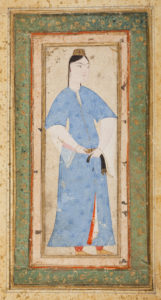
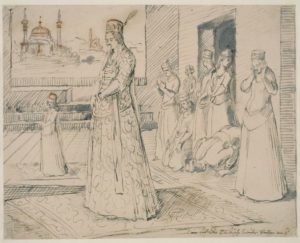
Small funnel-shaped hats came into fashion around the end of the century:
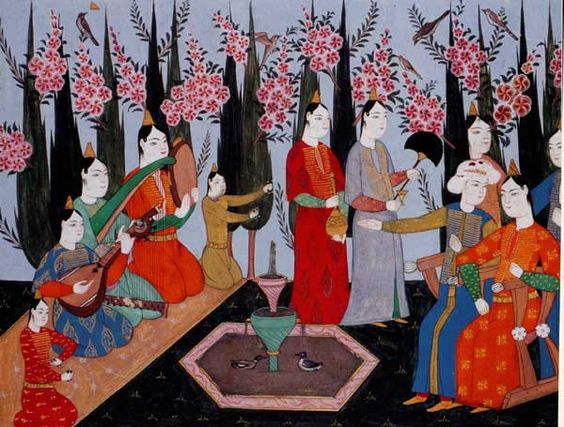
By 1618, the funnel had extended into a tall, tapered cylinder:
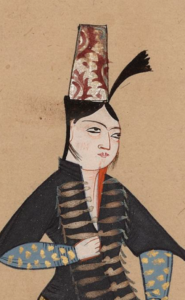
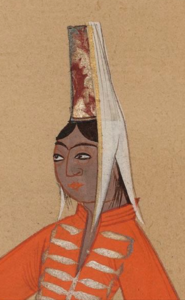
We have very little information about the funnel-shaped style, which appears to have been short-lived and may not have traveled outside the palace. However, we have plenty of visual sources for the pillbox style and the tall style. And while the tall style is post-period, it’s majestic, attractive, and a change from pillbox hats, which means it gets rolled out from time to time in the SCA. So, in the interest of keeping the “anachronism” in the Society for Creative Anachronism, here’s what we can deduce about the two styles of hat.
The Pillbox Hat (“Tarpuş”)
Sidebar: Why is it called a tarpuş?
As far as we can tell, different styles of women’s hats didn’t have names. All women wore the same types of hats, so their hats were just called whatever the most common word for “hat” was. Since the people of the day didn’t oblige us with names, later scholars have had to assign names, and the pillbox style ended up with the generic Arabic term tarboosh, or tarpuş.
From about the middle of the 16th century, a woman would probably have called her hat an arakiyye, regardless of style.
Pillbox hats are depicted in a range of sizes, from tiny enough to perch atop your head to large enough to go all the way around your head. The one constant is that they’re wider than they are tall. (So, no fezzes.)
European artists consistently depicted much wider hats than Ottoman artists, which suggests that smaller hats were stylish. To unpack that logic: European artists had no concept of what was fashionable or unfashionable in Ottoman clothes, and they were creating for an audience that also had no idea what was fashionable and just wanted to see what Ottoman women really looked like, so Europeans drew or painted what they saw in front of them. Ottoman artists, on the other hand, knew what was fashionable and were making art of stylishly dressed women for other people who knew what was fashionable, so they showed women wearing fashionably tiny hats. The idea that smaller hats are more fashionable is supported by the PITA Principle, which declares that the more of a pain in the ass a garment is, the more aristocratic and, therefore, the more stylish it is.
The practical application is that you can wear any hat size you like, as long as it’s wider than it is tall. Most women, even women wealthy enough to decorate their hats with jeweled chains, wore hats wide enough to sit comfortably on their heads. Fashion plates wore smaller, less practical hats.
How to Wear a Tarpuş
Step 1: Plop it on your head.
Many women stopped there. If your hat stays on without help and you’re not in the mood to fancy yourself up, why bother?
If your hat is too stylish to stay on by itself, you’re on your own. There are dozens of pictures of women wearing minuscule hats with no visible means of fixing them on. The only extant tarpuş is a) labeled a child’s cap, which it may well be, in which case it would sit securely on the head without help; and b) has no sign of ribbons, pins, or other means of holding it on. If you figure out how women in period kept their tiny hats on, entire Facebook communities of SCAdian Ottomans will hail you as a hero.
Step 2: Fancy it up.
The most common decoration was a çenber or çember, a band of cloth wound around the base of the hat. Surviving examples from Topkapi Palace are intricately embroidered bands tied in the back with strings. Other examples in art are narrow scarves wound around the base, with the ends tucked in.
Çember are not turbans! They’re too narrow and too low-profile to be even remotely mistaken for a turban. A turban was an exclusively male headdress, and a high-status one at that. No Muslim woman would wear a turban, any more than an Elizabethan woman would strap a codpiece over her skirts.
(There’s a famous drawing of a 15th-century Turkish woman wearing a tall, pointed headdress with a cloth wrapped turban-style around the base. The drawing is exquisite–use the zoom function to zoom in as far as you can, because the small versions you see around the web don’t do it justice. It’s expertly observed by a master artist who went to Turkey and drew from life. And it’s a drawing of a Druze, a non-Muslim who wore a distinctive headdress called a tantour, which no one but a Druze woman would have worn.)
Aigrettes were another popular decoration. Women could wear one or two–always at the sides, never at the back or front. The huge jeweled aigrette-like ornaments that go in the front are turban ornaments, and are male-specific.

Another decoration, less common, was the istefan, or diadem. This was a small metal “crown” that fit around the base of the hat. Some sources will tell you istefan were a sign of rank at court, but in real life, they were just another ornament. There’s even a painting of a toddler wearing an istefan as she accompanies her mother to the bathhouse.
We have one single source for chains festooning the hat, but it’s a good source, so I’ll allow it in. Melchior Lorichs’s sketch of a woman in a stunning istefan shows a chain of small square plaques, each with a ball (or bell?) dangling from it. The chain is looped behind the front point, and is either hooked to the back of the istefan or looped behind a back point.
Step 3: Tie it on.
If you need to hold your hat on, you can tie it on with a small veil called a makrame or makrama. This veil is only long enough to tie under your chin. You put it on by untying your çember, settling your makrame in place, and then tying the çember over the top to hold the makrame to the hat. Once the çember is tied, you can untie the makrame. Although the makrame is supposed to hold your hat on, many women wore it as decoration, as shown by the many paintings of women wearing untied makrame.
(Note: I’ve tried dozens of times to make the çember-and-makrame combination work, but every time I tie the makrame down, it sticks out at weird, unbecoming angles and looks like anything but the pictures. I pin my makrame to my hat and wear it untied. If you can figure out the magical combination of hat dimensions and makrame composition that make the style work, let me know.)



